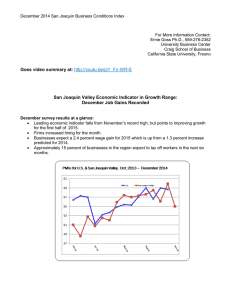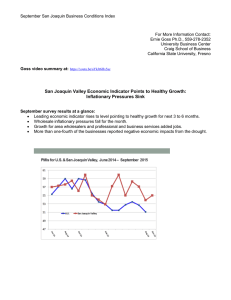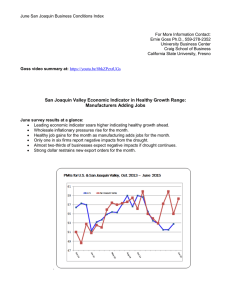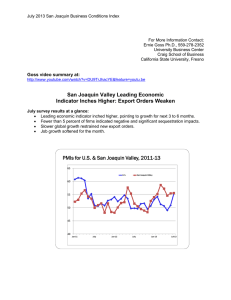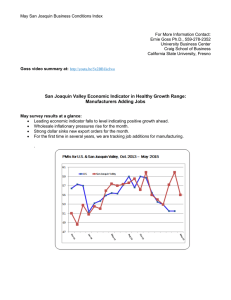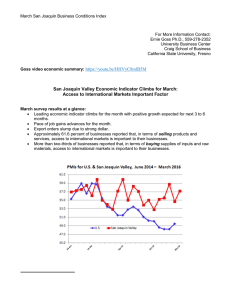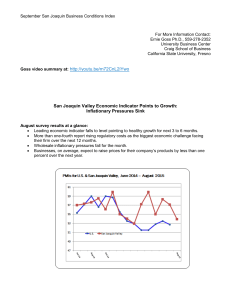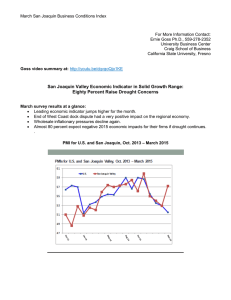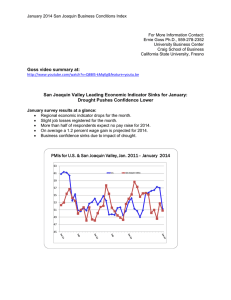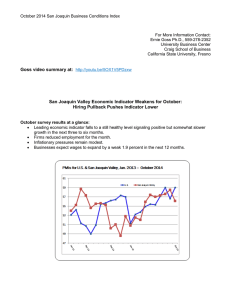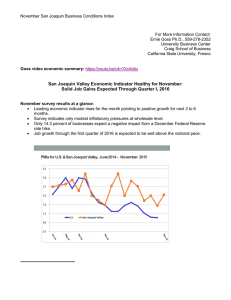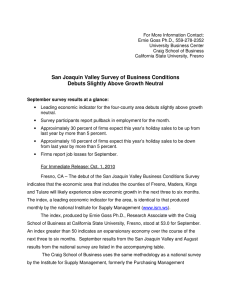Document 13092156
advertisement
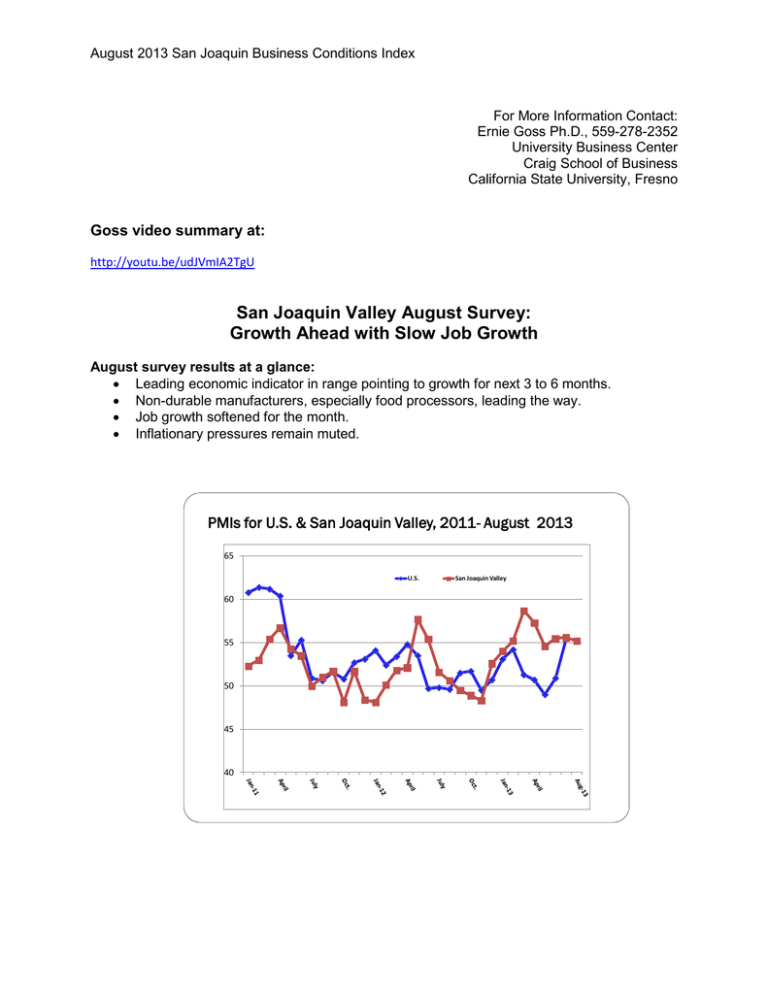
August 2013 San Joaquin Business Conditions Index For More Information Contact: Ernie Goss Ph.D., 559-278-2352 University Business Center Craig School of Business California State University, Fresno Goss video summary at: http://youtu.be/udJVmIA2TgU San Joaquin Valley August Survey: Growth Ahead with Slow Job Growth August survey results at a glance: Leading economic indicator in range pointing to growth for next 3 to 6 months. Non-durable manufacturers, especially food processors, leading the way. Job growth softened for the month. Inflationary pressures remain muted. PMIs for U.S. & San Joaquin Valley, 2011- August 2013 65 U.S. 60 55 50 45 40 San Joaquin Valley San Joaquin Business Conditions Index – p. 2 of 3 For Immediate Release: September 3, 2013 FRESNO, CA-For the ninth straight month, the San Joaquin Valley Business Conditions Index moved above growth neutral. The index, a leading economic indicator from a survey of individuals making company purchasing decisions for firms in the counties of Fresno, Madera, Kings and Tulare, points to improving economic conditions in the next 3 to 6 months. The index is produced using the same methodology as that of the national Institute for Supply Management (www.ism.ws). Overall Index: The dipped slightly to 55.4 from 55.6 in July. An index greater than 50 indicates an expansionary economy over the course of the next three to six months. Survey results for the last two months and one year ago are listed in the accompanying table. “The area economy is expanding, with the unemployment rate down by almost three percent over the past year. Instead of contracting like the U.S., the region's labor force has expanded. Nondurable manufacturing firms, especially food processors, continue to experience healthy business growth. Importantly, area construction activity is advancing but at a slow pace. Our surveys over the past several months indicate that this positive growth trend will continue well into the final quarter of this year, a significant improvement from the same period of 2012,” said Ernie Goss, Ph.D., research faculty with the Craig School of Business at California State University, Fresno. Employment: For the tenth straight month, the hiring gauge moved above the growth neutral threshold. The job index slid to a tepid but positive 51.2 from 54.2 in July. Readings over the past several months indicate that the job market will continue to improve for the rest of 2013. “Last month I indicated that I expected the area's unemployment rate to drop below 10.0 percent before the end of 2013. While this rate is still possible, it more likely that the jobless rate will not move below this threshold before the first quarter of 2014,” said Goss. Wholesale Prices: The prices-paid index, which tracks the cost of raw materials and supplies, fell to 52.5 from July's 58.9. “Wholesale inflationary pressures for the region are trending lower. Weakness in the global economy and a slowly rebounding national economy are restraining inflationary pressures at the wholesale level. Even though inflationary pressures remain muted, I still expect the Federal Reserve (Fed) to begin reducing or tapering their $85 billion monthly bond buying program at their Sept. 17-18 meetings," said Goss. Business Confidence: Looking ahead six months, economic optimism, captured by the business confidence index, inched higher to 51.1 from 50.4 in July. “International tensions, higher long-term interest rates and slower global economic growth continue to weigh on the economic outlook,” said Goss. San Joaquin Business Conditions Index – p. 3 of 3 The federal spending sequestration is having very little impact on the outlook. “The last six months, we have asked survey participants how the federal spending sequestration was affecting their company. In the August survey, approximately 80.0 percent of firms indicated that the cuts have had no impact on their company to date. Only one in five businesses reported impacts from sequestration with less than five percent indicating significant impacts,” said Goss. Inventories: Businesses once again reduced inventories for the month. The index remained below growth neutral but rose slightly to 46.3 from July's 44.6. A pullback in inventory levels is another signal of a downturn in the economic outlook as businesses anticipate slower, but positive growth in the months ahead. Trade: The new export order reading slumped to 42.7 from July's weak 43.7. At the same time, the import reading for August advanced to 50.5 from 47.9 in July. “Economic pullbacks and slowdowns in Asia and Europe along with increases in the value of the U.S. dollar are having clear negative impacts on sales abroad. The tepid import reading is another signal that firms, as a result of slow growth, are not buying vigorously from abroad,” said Goss. Other components: Other components of the August Business Conditions Index were new orders at 60.9, up from last month's 59.8; production or sales at 60.4, up from July's healthy 59.8; and delivery lead time at 58.2 which is a slight decline from 59.5 in July. Table 1 details survey results for August 2012, July 2013 and August 2013. September survey results will be released on the first business day of next month, October 1. Table 1: Overall and component indices for last 2 months and one year ago (above 50.0 indicates expansion) San Joaquin Valley August 2012 July 2013 August 2013 Leading economic indicator 50.6 55.6 55.4 New orders 47.7 59.8 60.9 Production or sales 47.4 59.8 60.4 Employment 48.6 54.2 51.2 Inventories 54.0 44.6 46.3 Delivery lead time 55.0 59.5 58.2 Wholesale prices 62.3 58.9 52.5 Imports 47.1 47.9 50.5 Export orders 34.8 43.7 42.7 Business confidence 38.8 50.4 51.1 Craig School of Business: http://www.craig.csufresno.edu/ Follow Goss: Twitter at http://twitter.com/erniegoss or www.ernestgoss.com Blog: http://economictrends.blogspot.com
